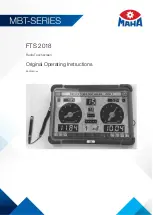
Page 8
2.
Safety Instructions
The autoclave has unique characteristics. Please read and understand
the operation instructions before first operation of the autoclave. The
following issues may require instructions guidance provided by the
manufacturer: how to operate the autoclave, the door safety
mechanism, the dangers involved in circumventing safety means, how
to ensure that the door is closed, and how to select a correct
sterilization program.
Make sure that you know where the main power switch is, where the
water cut-off valve is and where the compressed air disconnection
valves (if applicable) are located.
Autoclave maintenance is crucial for the correct and efficient function of
the device. We enclose a log booklet that includes maintenance
recommendations, with every device.
The weekly spore test is part of the preventive maintenance plan, along
with the annual validation of the sterilization processes that ensures
appropriate temperature dispersion within the chamber.
Never use the autoclave to sterilize corrosive products, such as: acids,
bases and phenols, volatile compounds, or solutions such ethanol,
methanol, or chloroform nor radioactive substances.
1.
Never start using a new autoclave before the safety, licensing and
authorization department has approved it for use.
2.
All autoclave users must receive training in proper usage from an
experienced employee. Every new employee must undergo a training
period under an experienced employee.
3.
A written procedure must be established for autoclave operation,
including: daily safety tests, seal inspection and door hinge
inspection, smooth action of the closing mechanism, chamber
cleaning, prevention of clogging and preservation from corrosion,
what is permitted and what is prohibited for sterilization and choosing
a sterilization program.
4.
Liquid
s may be sterilized only with the “liquids” programs. The
container must be covered but not sealed. Sealed bottles may only be
sterilized using a special program. The bottle must be either Pyrex or
a Borosilicate glass bottle. Verify that the two temperature sensors are
located inside two different bottles to assure that the liquid temperature
is 20°C below boiling temperature for sealed bottles at the end of the
cycle.
5.
When sterilizing plastic materials, make sure that the item can
withstand sterilization temperature. Plastic that melts in the chamber
is liable to cause a great deal of damage.
Содержание LabSci 11-V
Страница 19: ...Page 18 8 Right service door lock...
Страница 22: ...Page 21 10 Drain outlet...
Страница 34: ...Page 33 Attention This device is not a medical device and not intended for medical use...
Страница 35: ...Page 34 During the process the stages of the cycle will be displayed on the screen...
Страница 74: ...Page 73 1 Open the printer s cover door 1 by pulling it up see Fig 2 Fig 1...
Страница 79: ...Page 78...
Страница 90: ...Page 89 Attention Use protective gloves in order not to burn your hands with the hot steam Safety valve ring...










































